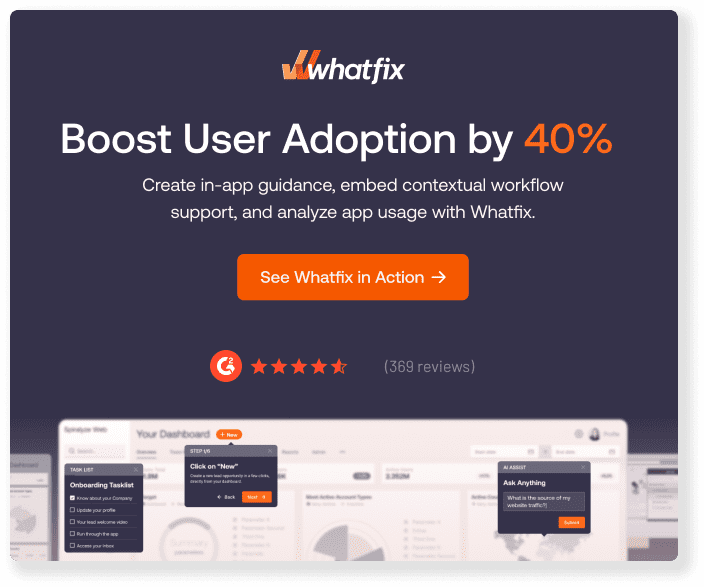Salesforce has an ambitious goal to “empower one billion agents with Agentforce by the end of 2025,” but adoption is lagging behind those projections. The company shared information about slower-than-expected Agentforce uptake in its latest earnings report.
While Agentforce offers a new approach to AI-powered productivity, many organizations struggle with implementation, user adoption, and demonstrating ROI. Preparing teams and integrating this technology into existing workflows is a challenge.
In this article, we’ll explore why Agentforce adoption often falls short and share an eight-step framework to help your organization successfully implement this powerful platform. We’ll also highlight how digital adoption solutions like Whatfix can accelerate the process.
Why Agentforce Adoption Is Low
Several barriers prevent organizations from getting value out of Agentforce. Understanding these challenges will help you overcome them. The core reasons vary from organization to organization, but the following challenges are consistent across AI implementations:
- Resistance to change and workflow concerns on AI
- Lack of understanding of how to use AI as an end-user
- Lack of awareness of Agentforce use cases
- Shiny object syndrome
Resistance to Change and Workforce Concerns on AI
Employee resistance remains one of the biggest obstacles to Agentforce adoption. Many workers worry that AI agents might diminish their value or even replace their roles entirely. AI adoption is accelerating, but concerns about job security and shifting responsibilities create friction.
According to Salesforce, thousands of organizations are using Agentforce. However, adoption rates are still lower than expected. When employees view Agentforce as a threat, engagement rates are low. Organizations that fail to address their teams’ concerns find themselves with powerful AI capabilities that no one wants to use.
Lack of Understanding of How to Use AI as an End-User
Agentforce requires employees to gain new skills. Many employees don’t know how to use AI agents effectively or craft effective prompts that lead to useful results, so average users don’t see the possible benefits.
Companies are underinvesting in employee training on AI tools like Agentforce. As a result, workers are left without the prompt engineering skills and conceptual understanding that would empower them to make the most of these powerful tools.
Not Aware of AI Use Cases
Organizations struggle to identify department-specific use cases that create value. Users need examples of how Agentforce can improve their workflows. Otherwise, employees see it as a learning tool, not a solution to their challenges.
The most successful AgentForce implementations tailor the platform to industry-specific needs. For example:
- Healthcare: Precina uses AgentForce to support type 2 diabetes patients, reducing administrative costs by $80,000 per year for every 5,000 patients they manage
- Customer Service: Wiley Publishing deployed AgentForce to handle service call spikes during peak enrollment periods, increasing self-service efficiency by over 40%
- Talent Acquisition: The Adecco Group uses AgentForce to automate resume screening and candidate shortlisting, streamlining their recruitment process
Use cases like these give Agentforce a clear purpose. Salesforce suggests starting with a quick-win use case. Look for something simple to execute but delivers immediate value to the business.
Shiny Object Syndrome: Leaders Wanting to Cut Corners
Executives who want to stay ahead of the AI curve may rush into adoption without laying the groundwork. This “shiny object syndrome” leads to implementations that don’t stand the test of time.
For example, companies may deploy Agentforce without cleaning up their data. Since Agentforce inherits existing Salesforce data and security settings, content management is essential. This limits the risk of exposing sensitive information or creating agents with incomplete data access.
8 Steps for Successfully Adopting Agentforce
Implementing Agentforce requires an approach that includes technology, people, and processes. These steps will help your organization maximize its investment
1. Define Agent-Specific Success Metrics
Start by establishing clear objectives that tie Agentforce to business outcomes. Identify KPIs linked to Agentforce performance, like case resolution time, first-contact resolution rates, and customer satisfaction scores.
Research shows that companies using Agentforce have reported 40% faster case resolution times and 25% higher lead conversion rates. Setting benchmarks that measure these improvements will help quantify the impact of your Agentforce implementation.
Track metrics like the decrease in agent onboarding time or growth in lead conversion rates. This will help you understand and explain Agentforce’s impact on your business.
2. Assess Your AI Ecosystem
Before implementing Agentforce, assess your current environment. This includes mapping current workflows in sales, service, and marketing teams. You’ll want to evaluate data quality and identify potential issues that could impact Agentforce performance.
This phase is important because Agentforce is only as effective as the data it can access. Organizations with clean, well-structured Salesforce data will see better results than those with disorganized information.
You’ll need to review existing integrations and user readiness. Survey your team and ask questions like:
- What repetitive tasks take up a lot of your time?
- Which parts of your current workflow feel frustrating?
- What information do you frequently need to search for?
Once you decide to implement the platform, consider Salesforce’s free course, which will help you understand how AI and agents can transform jobs and launch your first agent.
3. Customize Agentforce for Your Operations
Agentforce implementation looks different for every business. You can tailor the platform to your needs by designing custom agent skills for your business processes. This customization makes Agentforce a natural extension of operations.
For customization to be effective, consider integration points with your existing systems. Then, configure security settings to support data governance and stay in compliance with regulations in your industry.
Studies show that organizations using Agentforce can achieve ROI up to five times faster with at least 20% lower total cost of ownership compared to DIY approaches. This customization phase is an important part of making that happen.
4. Implement Agent-Centric Training & Onboarding
Effective end-user training can make or break Agentforce adoption. Offer learning programs that include interactive, in-app guides for real-time assistance and role-specific tutorials addressing the scenarios users deal with. Simulation environments also allow users to practice with Agentforce safely.
Hands-on experience is essential for building confidence. When users can experiment with capabilities like data analysis or automated workflow creation in safe environments, they’re more likely to incorporate these features into their work.
Use hands-on labs and simulation exercises to build user confidence through practical experience. Whatfix Mirror lets you create safe sandbox environments where users can practice Agentforce prompts and features without fear of making mistakes in live systems. These simulation environments are valuable for building proficiency with Agentforce capabilities like lead qualification or content optimization.

Also, set up a knowledge base where employees can find resources, ask questions, and share best practices. With Whatfix’s native knowledge base integrations, organizations can embed their knowledge directly into their digital apps for internal employees, customers, and end-users. This provides on-demand, self-help support in the moment of need.

5. Launch a Pilot with a Focused Agent Group
Start small with a carefully selected group to validate Agentforce’s value in your organization. Choose a representative team with mixed technical abilities. This way, the implementation works for everyone, not just power users. To get momentum, select use cases with high potential for immediate impact.
Come up with success criteria for the pilot to help you evaluate results. Then get feedback on usability and performance to find opportunities to improve future deployments. This reduces risk and creates champions who can advocate for Agentforce in your organization.
According to Dion Hinchcliffe, vice-president and practice lead of CIO Insights for Futurum Group, Agentforce customers go live in just 4 to 6 weeks. When you handle the rollout the right way, the value quickly follows.
6. Roll Out in Phases Across Agent Teams
After a successful pilot, scale deployment in logical groups, like by business unit. This can decrease the confusion and resistance of adding new technology to your organization.
Be sure to provide support during each phase of expansion and give teams the resources they need to succeed with Agentforce. When you apply the lessons you learn along the way, each deployment will be more successful than the last.
As implementation expands, build a network of internal experts who understand Agentforce and the needs of their department. This creates learning communities where employees can support each other. Also, take advantage of official Agentforce resources from Salesforce.
7. Leverage Real-Time Analytics for Continuous Improvement
Data-driven decisions lead to better outcomes. Use Agentforce analytics to monitor agent interactions and how the technology impacts operations. These insights help quantify the impact of Agentforce and identify opportunities for improvement.
Track patterns in different teams to spot success stories and adoption challenges. Identify areas where users might need additional support. As adoption grows, measure progress against your established KPIs to see what’s working and what isn’t.
The most meaningful metrics connect to business goals, like how customer service resolution times decrease or how sales conversion rates improve after Agentforce adoption. These outcomes-focused measurements help you understand the value.
8. Establish Ongoing Agent Support & Innovation Cycles
Agentforce adoption isn’t a one-time project. Create dedicated support channels to help users connect and solve problems. Schedule regular check-ins to address concerns and share success stories, too.
You’ll need to focus on continuous improvement based on user feedback. Also, stay updated on new Agentforce capabilities through Salesforce’s regular releases so your implementation is always current.
How to Drive Agentforce Adoption with Whatfix
Digital adoption platforms like Whatfix can accelerate and enhance the implementation of Agentforce. Whatfix helps your team make the most of what Agentforce has to offer. Here’s how.
1. Interactive Flows & Task Lists for Agent Guidance
Guide employees through Agentforce’s most valuable features with step-by-step interactive walkthroughs in the Salesforce interface. Whatfix’s no-code visual editor lets you create customized flows that walk users through processes like building AI agents or analyzing performance data.
These interactive guides reduce the learning curve for Agentforce and empower employees with new AI capabilities. By embedding guidance in the application, Whatfix removes barriers to adoption.
Whatfix also allows you to create task lists and break Agentforce activities into manageable steps. This contextual help appears when and where users need it, allowing them to build confidence.
Companies like Experian have dramatically improved software adoption with Whatfix’s in-app guidance. One Experian specialist noted, “Whatfix empowers us to get the right training to the right people at the right time.” Employees can immediately apply what they’ve learned to their work.
2. Smart Tips, Pop-Ups & Beacons for Contextual Nudging
Capture your team’s attention and boost Agentforce proficiency with strategic guidance elements from Whatfix. These elements include:
- Smart Tips: Deliver instant guidance during important interactions in Agentforce
- Pop-Ups: Introduce new features or best practices
- Beacons: Draw attention to important but easily overlooked functionality
These features create “aha moments” that turn occasional Agentforce users into power users. Companies implementing Whatfix have seen user engagement rates soar as employees learn how to make the most of new tools.
3. Self-Help Integration for On-Demand Support
Empower your team with on-demand Agentforce support with Whatfix Self-Help. This in-app knowledge hub provides answers to questions in the application. Users can get support without sacrificing productivity.
Your goal should be building a library with searchable articles, video tutorials, and quick guides. Video resources can show how different departments can use Agentforce’s capabilities. Users may access short, focused videos that show how to apply Agentforce to their job.
Effective Self Help reduces support tickets and increases user confidence. Providing guidance on crafting effective prompts or troubleshooting common issues accelerates Agentforce adoption.
4. Embedded Surveys for Real-Time Feedback Collection
Get real-time insights on your Agentforce implementation with Whatfix’s in-app surveys. This way, you can capture user feedback at critical moments in their adoption journey. Contextual surveys can assess user confidence with specific Agentforce features or highlight training opportunities.
This feedback loop helps you refine your Agentforce adoption strategy based on actual user experiences, not assumptions. Use these insights to tailor training sessions to address specific pain points or knowledge gaps. By customizing learning content based on feedback, you’ll create more relevant training experiences that address user challenges.
5. Whatfix Analytics to Monitor & Optimize Agent Adoption
Improve your Agentforce strategy with detailed usage insights from Whatfix Product Analytics. Track which Agentforce capabilities are being embraced and which are underutilized. This visibility helps target your enablement efforts where they’ll have the greatest impact.
Our powerful analytics dashboard helps you identify usage patterns and make data-backed decisions about where to focus your adoption efforts. Leading organizations use these insights to identify power users who can become internal champions. They can also spot departments that need additional support and quantify the ROI of their Agentforce investment.
Agentforce Adoption Clicks Better With Whatfix
Successful Agentforce adoption demands a strategic approach that aligns people, processes, and technology. While Salesforce’s digital labor platform offers transformative potential, realizing its full value requires thoughtful implementation and user enablement.
From there, you can create a digital workplace where Agentforce capabilities are fully realized. Whatfix supports this journey with:
- Whatfix Mirror: Accelerates Agentforce adoption with hands-on, interactive training in risk-free environments. This reduces implementation time and allows employees to master essential Agentforce skills without fear of making mistakes in live systems.
- Product Analytics: Provides real-time visibility into Agentforce usage patterns to help teams identify adoption challenges and make data-driven decisions based on actual user behavior.
- Whatfix DAP: Supports users with contextual in-app guidance through step-by-step walkthroughs. This reduces training costs and increases adoption rates for Agentforce features.
With Whatfix for AI adoption, organizations can drive measurable improvements in Agentforce transformation, boost AI technology ROI, and convert promising AI capabilities into actual business value.
Discover how Whatfix can turn your Agentforce implementation into a competitive advantage. Get a demo today.













